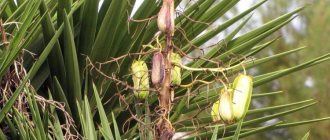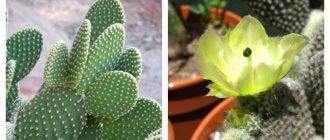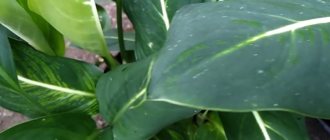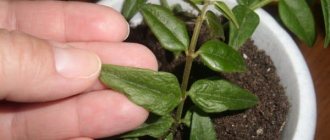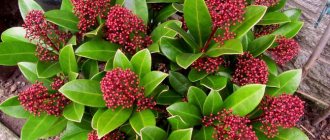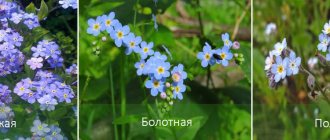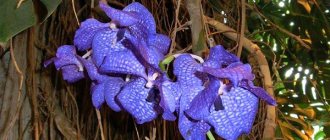Author: Elena N. https://floristics.info/ru/index.php?option=com_contact&view=contact&id=19 Category: Houseplants Published: June 22, 2017Last edits: January 11, 2021
- Cuttings
- Pests and their control
- Hatiora salicornioides
Hatiora (lat. Hatiora) is a genus of epiphytic cacti from the tropical forests of Brazil, numbering, according to various sources, from five to ten species, some of which are grown indoors. Some taxonomists include Hatiora in the genus Rhipsalis. At first, the genus was named “Hariota” in honor of Thomas Harriot, a famous English mathematician and traveler who was one of the first explorers of the nature of America. But then it turned out that this name had already been assigned to another plant, and it was necessary to use an anagram: chariota - hatiora.
Features of an indoor flower
Hatiora is a unique plant that has neither leaves nor branches. It consists of individual segments of a flat, cylindrical or bottle shape. They are connected to each other by air membranes.
Grows in the form of a bush. The shoots are erect, but over time they begin to droop under their own weight. Additional support may be required.
It blooms with small flowers that look like bells with many small petals. Flowers appear only at the tips of the upper young shoots. On some varieties, translucent oblong berries appear after flowering.
The plant belongs to the cactus family, but it does not have spines . Instead, a fluffy white coating is visible on the shoots. Hatiora shoots are very fragile and break off easily. Therefore, you should not fiddle with it again.
What are the different types of Hatiora?
There are a large number of plant varieties. But, the following types of hatiora are usually grown indoors:
- Saltwort - the stems are round in cross section, the segments of which very much resemble skittles or bottles. It's no wonder that in the UK this variety is often called "an alcoholic's dream." This species blooms mainly in spring.
- Pink - the stems are flat, with green oval segments and pink edging. The flowers of this species are large and deep pink.
- Germina - stems are straight, with even cylindrical segments. The flowers are crimson.
- Gartner - it is very similar to pink in appearance. Only the flowers here are larger, their diameter can reach 5 cm.
- Gresera is a hybrid created from pink hatiora and gartner. The flowers are red-burgundy.
- Five-winged - pentagonal stems. Externally, the plant resembles a small shrub. The flowers are small and white.
Care
Caring for the plant at home is quite simple, so even a novice gardener can handle it. Hatiora is completely unpretentious and not capricious. It is enough to follow simple rules when growing it, and it will delight you with its lush flowering for a long time.
Illumination
If hatiora grows in an apartment, then it is better to keep it on windows facing east or west. The plant loves bright diffused light , the main thing is to protect it from direct sunlight.
It also feels good on the south side, but here it must be specially shaded or placed at some distance from the window. Tender shoots can get burned if hathiora is kept in full sun.
If there is not enough light, the shoots may stretch, and subsequently the plant will bloom poorly.
Temperature
Hatiora is a heat-loving plant, like all succulents. During the period of active growth and flowering, the preferred temperature is +20 – +26°C. In summer, the ideal option would be to take it out onto the balcony or open terrace. Differences between day and night temperatures are even useful for her, if they do not exceed 5-6°C. In winter, when the flower is dormant, the temperature should be lowered to +10°C.
Air humidity
Increased air humidity will have a beneficial effect on the plant, especially during the growing season. Dry air in apartments can affect the intensity of flowering. Therefore, you need to take measures for additional hydration.
The flower should be regularly sprayed or washed in the shower with warm water . In particularly hot weather, place a home humidifier next to the pot. You can immerse the plant along with the flowerpot in a container filled with wet expanded clay or small pebbles.
Trimming
Hatiora is distinguished by its widely growing crown. To create a beautiful shape, the plant should be pruned periodically. The best time for this is early spring, after the plant has finished blooming. To do this, excess parts of the shoots are removed manually. This must be done carefully by twisting at the junction of the segments. This way the flower will be less injured.
Watering
Hatiora requires watering only during the period of active growth and flowering . Water with warm and well-settled water. In this case, you need to ensure that the soil has time to dry well between waterings.
Do not allow water to stagnate. This can lead to rotting of the roots or the appearance of brown spots on the branches.
To avoid this, you need to drain the water from the pan immediately after watering. Wrinkled plant segments will indicate insufficient watering.
In winter, watering is kept to a minimum. It is enough to water the plant once every 3-4 weeks. At this time, hatiore has enough water contained in the stems. In winter, buds are formed for future flowers, and if the correct watering regime is followed, the plant will bloom very actively and profusely.
Fertilizer
They begin to fertilize hatiora from the beginning of spring until the end of flowering . They do this 2 times a month. Mineral fertilizer for succulents is chosen as a top dressing.
Please note that the fertilizer contains potassium (for bright coloring of flowers) and phosphorus (stimulates flowering). But calcium and nitrogen are undesirable. It is better to apply fertilizer in liquid form, so it is better absorbed by the plant. In winter, when the plant is dormant, there is no need to feed it.
Transfer
Young plants should be replanted annually, older plants - once every 2-3 years. If the flower is very old, then it can be replanted every 5 years .
Hatiora easily tolerates the transplant. It belongs to epiphytic plants, in which the root system is rather poorly developed and the roots are close to the surface. Therefore, choose a shallow and wide pot. Replanting should only take place after the plant stops blooming.
Be sure to place a layer of drainage at the bottom of the pot, to which you can add a little crushed charcoal. The soil should be chosen specifically for succulents. The plant requires slightly acidic or neutral soil. It should be sufficiently loose and permeable.
Transplantation is carried out by transferring the plant from one pot to another . The difference in pot sizes should be small. During transplantation, you must carefully examine the root system and remove dried or rotten parts.
Features of hatiora transplantation
Before replanting the hatiora, you need to wait until the flowering period ends. It should be remembered that the roots of the cactus are near the surface, so choosing a large pot does not make sense. You can add fresh soil only after calcining the soil.
For a flower, it will be correct to choose low acidity of the soil. To make the soil loose, you should add charcoal, peat, and coarse sand. If there are dry or rotten soft parts in the root system of the hatiora, they are cut off.
With proper care, the hatiora will be completely covered with buds by the time it blooms.
Reproduction methods
Hachiora is easy to propagate on your own. The procedure is best carried out in spring and summer, during active growth. There are several ways to do this:
- seeds;
- cuttings;
- vaccinations.
Propagation by seeds is the most labor-intensive and ineffective method. It is used mainly by breeders.
Cuttings
To root the plant, it is enough to break off a small part of the shoot, consisting of 3-4 segments.
It should be broken off by twisting at the thinnest point, where the barrel segments connect. Sprinkle the broken area with crushed coal. Then place the cuttings in a shaded place for a couple of days so that they dry out and then root. If you take a large fragment of a plant for rooting in order to immediately get a large flower, then it should be dried for at least a week. Some gardeners do not dry the cuttings, but place them in water. When they sprout roots they are planted.
The rooting substrate should be taken from a sand-peat mixture . Place the flower in a warm and bright place, protected from bright sun and drafts. Water with caution.
Hatiora takes root quickly. Sometimes fragile segments of the trunk can break off chaotically and, once on the soil, germinate on their own.
Graft
Reproduction by vegetative means or by grafting is a more troublesome method. It requires special skills and practice. But as a result, it produces a profusely flowering plant. It is better to graft Hatiora in the summer. As a rootstock you can take perexia spinosa.
The shoot of the rootstock, where there is a branched part, is cut off . At the point of branching, the trunk splits.
- Break off a stalk of 2-3 segments from the hatiora and sharpen its lower part.
- Then install the cutting with the pointed end instead of splitting the rootstock and secure.
- Once you are sure that the grafted plant has begun to grow, the fixing bandage can be removed.
- Place the plant in a sheltered place at a temperature of about 20°C.
The grafted plant takes root within 2-3 weeks.
Plant propagation at home
Hatiora is easily propagated vegetatively:
- After flowering, the tops of the stems with 2–3 segments are broken off. Dip the broken areas in crushed charcoal and leave the cuttings to dry overnight.
- The next morning, the cuttings are planted in small pots or plastic cups filled with a mixture of equal parts of coarse sand and peat.
- The containers are regularly moistened, avoiding stagnation of water.
- After 1.5–2 months, the cuttings will take root, and next year they can be planted in permanent pots.
Beautifully flowering species are often grafted onto Peresia spinosa. This applies to Hatiora Gartner and Hatiora rosea. The procedure is carried out in the summer. Sequence of work:
- The entire branched part of the pereskia is cut off, leaving only an even stem. In hatiora, a cutting with 2–3 segments is broken off.
- The rootstock (hatiora cuttings) is split 2–3 cm with a sharp knife.
- The scion (pereskia) is sharpened on both sides with a flat wedge and inserted into the split rootstock.
- Carefully wrap the grafted plants with adhesive tape or tape. Make sure that the sections are in close contact with each other.
- Keep the grafted flower at a temperature of about 20 °C, water regularly, all shoots below the grafting site are removed when they appear.
- After the grafted hatiora begins to grow, the patch is removed. This usually happens 20–30 days after vaccination.
Grafting hatiora allows you to achieve lush and long-lasting flowering
Diseases and pests
Hatiora is susceptible to fungal and bacterial diseases. To prevent diseases when replanting a plant, the root system is treated with a solution of potassium permanganate.
Pests
In summer, hatiora can be attacked by pests that suck the juice from the stems . These include:
- whitefly (damaged shoots become covered with whitish spots and turn yellow);
- mealybug (white spots on the stem);
- spider mite (yellow dots on shoots);
- scale insects (sticky spots on shoots).
If you catch the pests at the initial stage and the damage to the plant is not too great, you can wash the flower under a warm shower with soapy water.
But if the disease is already advanced, then you will have to use insecticides. They need to spray the plant. After two weeks, the procedure is repeated. The infected plant must be removed away from all other indoor flowers.
Diseases
- Late blight appears due to improper watering or stagnation of water. The plant withers and turns pale. To solve the problem, spray the hathiora with a fungicide.
- Fusarium damages the root collar. It enters the plant through damage or pest bites. The affected area should be cleaned, then also treated with a fungicide.
- Bacterial infections affect young shoots. Individual segments acquire a brown tint, and wet spots with a rotten smell appear on them. In this case, the affected shoots are removed, and the plant is treated with anti-mold preparations. This will only help at the initial stage of the disease.
If the process has already started, then it is better to get rid of the diseased plant and grow a new one.
Why doesn't it bloom?
Hatiora does not bloom for several reasons:
- improper care and maintenance during the rest period;
- lack of nutrients;
- dry air;
- room too dark;
- cramped pot.
Why does it turn yellow?
Affects yellowing:
- pests;
- excessive watering.
Aftercare mistakes and how to avoid them
Common mistakes made in the process of breeding hatiora include the following:
- Insufficient watering - gradual drying of plant parts, formation of dry, brown spots on stem segments. The situation is corrected by timely moistening of the earthen coma.
- Heavy substrate with insufficient nutrients – no flowering. In this case, the necessary fertilizers are applied or the flower is transplanted into new soil.
- Low humidity levels in the room mean lethargy of the stems. To correct the problem, the bush is periodically sprayed with a spray bottle. It is also recommended to place the pot on moistened pebbles or place containers filled with water near it.
- Excessive soil moisture - rotting of the root system. In this case, the plant needs replanting and normalization of the watering regime.
- An excess of nitrogen fertilizers and organic matter damages the root system. It is necessary to reduce the frequency of fertilizing, and then carry it out taking into account the life cycle of the plant.
- The presence of drafts means drying and yellowing of the tops of the stems. The pot with the succulent is moved to another place.
In order to prevent the death of a flower, it is important to avoid errors in the process of propagation and further care of it, as well as to promptly eliminate problems that arise. If you follow all the recommendations, you can grow a lush, spreading bush in just a few years.
Types with photos and names
Salicornosa (Hatiora salicornioides)
This is the most common type of hatior. It is distinguished by particularly thin and fragile shoots. Small segments reach no more than 2.5 centimeters in size and are shaped like bottles. The size of an adult plant is about 40 centimeters. It blooms with yellow, pink or orange flowers. After flowering, small berries appear on the shoots.
Pink (Hatiora rosea)
The shape of the segments is flat, slightly ribbed . On the sides there are rudimentary spines in the form of light hairs. This species is distinguished by large pink flowers.
Hermine (Hherminiae)
The segments are round in shape up to 5 centimeters in length. Grows in the form of an upright bush. During flowering it is covered with dark pink flowers.
Gartner
The size of the flat segments reaches 7 centimeters. They have small notches along the edges. It blooms with large flowers of red or crimson hue.
Graeseri
This is a hybrid species created by crossing two species of plants - Hatiora rosea and Hatiora Gartner. The shape of the shoots is flat. Burgundy-red flowers appear in spring .
Five-winged (Pentaptera)
The segments consist of five faces. It grows as a shrub with drooping shoots. Blooms with white small flowers.
History of the name Hatiora
The name of the plant comes from the name of the English scientist Hariot. At first they called him that. Moreover, the genus of plants now called rhipsalis was called chariots. True, time has changed the name a little.
But Hariot himself has no direct connection to the plant. It was discovered in Brazil at the beginning of the last century by scientists D. Rose and N. Britton. And they dedicated this name in gratitude for the excellent maps created by Hariot, which helped them navigate the area.
Hatiora (photo presented in the article) has several more popular names. She is called the "dancing skeleton." Looking at the appearance of the plant, it is difficult to disagree with this name.
One type of hatiora, salicornia, consists of segments shaped like a bottle. It's no wonder it's called the Drunkard's Dream or the Spicy Cactus.
Signs associated with the plant
Hatiora is often popularly called “Male Tears” . Some believe that it provokes quarrels in the family or causes divorce. Men do not stay in the house where hatiora grows. But not particularly superstitious flower growers have found a way out and recommend not placing a pot with a plant in the bedroom.
Another belief says that hatiora is a poisonous flower. But there was no scientific evidence for this.
Hatiora will not harm children or pets. In order not to worry about this, you should not place the flower in children's rooms and in places accessible to your pets.
How to care?
Caring for an indoor flower involves performing the following simple steps.
Watering
The frequency and abundance of watering will also vary depending on the season. In summer, the supply of moisture should be regular; in the autumn months, the frequency of watering is reduced; in winter, moisturizing the cactus can be stopped altogether. However, the introduction of moisture must be dosed; when watering, it is necessary to ensure that liquid does not stagnate in the pot with the plant; the soil must be moist, but not flooded.
Water the cactus with settled water at room temperature. It is better to make several holes in the pot with the crop to allow excess moisture to escape.
Top dressing
The best time to use fertilizer will be from April to September, as well as the flowering period of the cactus. The grower must provide the crop with additional nutrition in liquid form, introducing the formulations twice a month. In this case, it is worth using specialized fertilizers intended for cacti, which will have a high nitrogen content and a reduced amount of calcium.
Trimming
For indoor cacti, another main nuance regarding full development is regular pruning to shape the crown. This should be done manually, without using garden tools or knives.
The owner of the perennial will need to independently separate the excess shares from the shoots; they should not be torn off, but carefully scrolled, this way it will be possible to avoid unnecessary injury to the plant
Characteristics
- Type: Succulent.
- Flower/fruit color: Pink, yellow, red.
- Leaf color: Green.
- Sun requirement: High.
- Size: 30-50 centimeters.
- Flowering: February-March.
- Aroma: Delicate, refined.
Whatever hatiora you choose, already in winter you will get a real “waterfall” of cascading flowers. In the cold season, they will look especially unusual in the room, as if reminding you of the approach of spring. Simple care and undemanding conditions will give you confidence if you decide to place this unusual plant in your home.
Plant varieties
Today there are many subspecies of this flower in the world (for example, San Pedro cactus, steel cactus, Peruvian cactus, etc.). Let's look at the most popular varieties of Cereus.
Peruvian
Among the huge representatives of this species, it is worth noting the Peruvian Cereus cactus. Its second name is the Scala cactus. The plant has a gray-green stem, which is characterized by a cylindrical shape. Moreover, in this subspecies, clearly visible ribs are formed on the shoot.
Despite the fact that in the wild it is a large flower, in an apartment it can grow to a maximum of 100 cm. This representative of the domestic flora blooms with white flowers that exude a pleasant aroma. The buds open at night. After flowering is completed, a fruit is formed in their place - an orange or red berry. You can eat it.
Azure
This variety got its name because of the unusual blue color of its stem. The plant is covered with a silvery-bluish coating. The shoot branches heavily, forming poorly visible ribs with felt or wavy edges. Cereus azure blooms with fragrant white flowers.
Brazil is considered the homeland of this subspecies. The plant has tree-like features. A distinctive feature of the cactus is the formation of lateral stems. Many spines are formed on the shoot, which are arranged radially. Usually their size is 1 cm. This is a rather tall flower. It can grow to a height of 3 m. At home, the maximum length of the flower is 20–25 cm, and the diameter is 8–10 cm.
Cereus strong
In the wild it is found in Argentina and Bolivia. Externally, the plant has the appearance of a shrub that grows to a height of 2 m. This is not the largest specimen, but one of the most branched. The flower forms about 5–8 shoots, which are located on the sides of the main stem. The shoots are colored bluish-green or light green. Its ribs usually number about 4–8 units.
The stem has radially arranged spines (3–5 units). They are colored yellow-gray. The spines are hard and grow 2 cm in length.
During flowering, the Cereus strong cactus forms red or white buds. After the flowering period ends, the plant produces a fruit with white or red flesh.
Spiral
It is a perennial flower that forms a fleshy stem. Usually the shoot has a spherical shape. But there are raised or flat specimens. Usually no leaves form on the stem. But there are a lot of thorns on the shoot. Their length is about 2–3 cm.
White-pink flowers appear on the sides of the shoot. They are quite large and have a beautiful appearance.
Difficulties in growing hatiora
Like any flower, hatiora is susceptible to various damages. These could be fungal diseases or improper care conditions. The reasons may be different, each is indicated by certain signs. So, why doesn't the hatiora bloom? The reason for this may be:
A little effort in caring for your favorite plant will bear fruit; the plant will delight the eye with the bright green color of its branches all year round, as well as beautiful yellow warm flowers in the coldest and grayest period - in winter, most often on Christmas Eve.
Having learned all the rules for growing this plant, anyone can decorate their home with such a delightful and unusual flower. Hatiora will appeal to people who know a lot about tropical and exotic flowers, and will not leave any true gardener indifferent.
Hatiora is an indigenous inhabitant of Brazil, growing in its tropical forests. This small succulent shrub is a relative of the familiar cactus. Hatiora belongs to the genus of epiphytic (develop on trees), and less commonly lithophytic (grow in rock gorges) cacti. When grown at home, this plant does not exceed 30-50 cm in height. But in its homeland, this type of cactus can grow up to 1 meter.
Plants of this genus were named Hatiora by botanists who used maps compiled by the Englishman Thomas Herriot in their scientific expeditions. The surname of this particular cartographer became an anagram of the name of the plant genus.
At the moment, I distinguish two subgenera of this plant species, which differ in their structure and shape. Of all the known species of hatiora, only four are suitable for home cultivation.
Mr. Summer resident warns: difficulties in caring for hatiora
Hatiora is not a capricious plant, but sometimes there are certain difficulties when growing it:
- poor growth and/or lack of buds is associated with low temperature in the room or lack of nutrients;
- weakening of leaf tugor and root rotting are a sign of stagnant moisture or drying out of the soil;
- the appearance of light spots - the plant has been exposed to excessive sunlight;
- falling of flowers and buds - drafts or sudden movement of the plant.
Pruning and shaping the hatiora crown
In order for this unusual cactus to develop evenly and for a thick crown, the plant must be pruned after flowering. Cut off or pinch off the outermost 1-2 segments to stimulate branching. Don’t worry that ripsalidopsis will become capricious: the succulent tolerates pruning well.
Feed the flower with complex fertilizer for cacti and soon it will thank you with thick green shoots, which will form buds for flowering in the new season.
Description
Hatiora has unusual external characteristics that are exotic for our latitudes: it can be mistaken for a bush, a herbaceous plant and a beautiful flower with bright colors at the same time. It all consists of leafless branches, slightly drooping or taking a stable upright position. The bare stem eventually turns into a woody trunk.
The lack of foliage is more than compensated for by funnel-shaped flowers that appear along the entire length of the stem shoots and their extraordinary beauty in color: pink-lilac, yellow, red.
In its natural habitat, hatiora can grow on the bark of trees (epiphytic forms) or form in rock crevices (lithophytic forms). At home, a succulent is a decorative potted flower with small spines on the lateral areoles.


